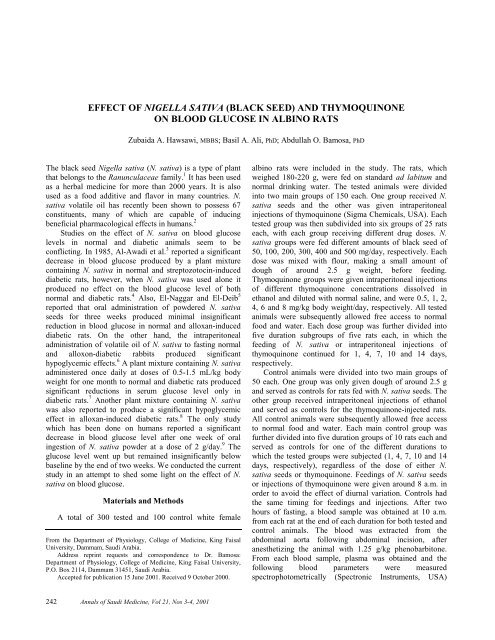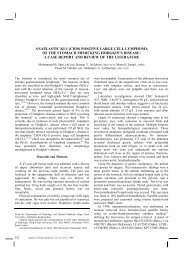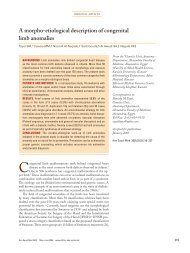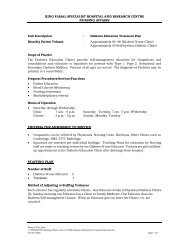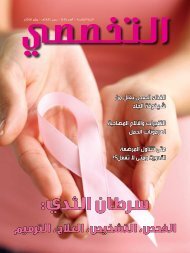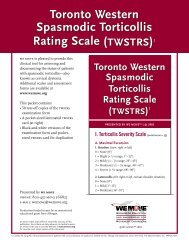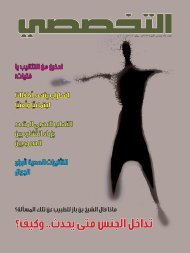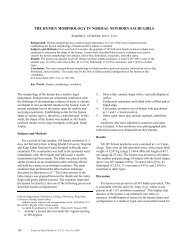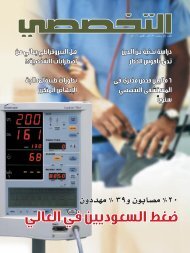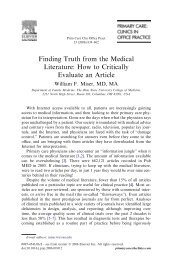effect of nigella sativa (black seed) and thymoquinone - ResearchGate
effect of nigella sativa (black seed) and thymoquinone - ResearchGate
effect of nigella sativa (black seed) and thymoquinone - ResearchGate
You also want an ePaper? Increase the reach of your titles
YUMPU automatically turns print PDFs into web optimized ePapers that Google loves.
EFFECT OF NIGELLA SATIVA (BLACK SEED) AND THYMOQUINONEON BLOOD GLUCOSE IN ALBINO RATSZubaida A. Hawsawi, MBBS; Basil A. Ali, PhD; Abdullah O. Bamosa, PhDThe <strong>black</strong> <strong>seed</strong> Nigella <strong>sativa</strong> (N. <strong>sativa</strong>) is a type <strong>of</strong> plantthat belongs to the Ranunculaceae family. 1 It has been usedas a herbal medicine for more than 2000 years. It is alsoused as a food additive <strong>and</strong> flavor in many countries. N.<strong>sativa</strong> volatile oil has recently been shown to possess 67constituents, many <strong>of</strong> which are capable <strong>of</strong> inducingbeneficial pharmacological <strong>effect</strong>s in humans. 2Studies on the <strong>effect</strong> <strong>of</strong> N. <strong>sativa</strong> on blood glucoselevels in normal <strong>and</strong> diabetic animals seem to beconflicting. In 1985, Al-Awadi et al. 3 reported a significantdecrease in blood glucose produced by a plant mixturecontaining N. <strong>sativa</strong> in normal <strong>and</strong> streptozotocin-induceddiabetic rats, however, when N. <strong>sativa</strong> was used alone itproduced no <strong>effect</strong> on the blood glucose level <strong>of</strong> bothnormal <strong>and</strong> diabetic rats. 4 Also, El-Naggar <strong>and</strong> El-Deib 5reported that oral administration <strong>of</strong> powdered N. <strong>sativa</strong><strong>seed</strong>s for three weeks produced minimal insignificantreduction in blood glucose in normal <strong>and</strong> alloxan-induceddiabetic rats. On the other h<strong>and</strong>, the intraperitonealadministration <strong>of</strong> volatile oil <strong>of</strong> N. <strong>sativa</strong> to fasting normal<strong>and</strong> alloxon-diabetic rabbits produced significanthypoglycemic <strong>effect</strong>s. 6 A plant mixture containing N. <strong>sativa</strong>administered once daily at doses <strong>of</strong> 0.5-1.5 mL/kg bodyweight for one month to normal <strong>and</strong> diabetic rats producedsignificant reductions in serum glucose level only indiabetic rats. 7 Another plant mixture containing N. <strong>sativa</strong>was also reported to produce a significant hypoglycemic<strong>effect</strong> in alloxan-induced diabetic rats. 8 The only studywhich has been done on humans reported a significantdecrease in blood glucose level after one week <strong>of</strong> oralingestion <strong>of</strong> N. <strong>sativa</strong> powder at a dose <strong>of</strong> 2 g/day. 9 Theglucose level went up but remained insignificantly belowbaseline by the end <strong>of</strong> two weeks. We conducted the currentstudy in an attempt to shed some light on the <strong>effect</strong> <strong>of</strong> N.<strong>sativa</strong> on blood glucose.Materials <strong>and</strong> MethodsA total <strong>of</strong> 300 tested <strong>and</strong> 100 control white femaleFrom the Department <strong>of</strong> Physiology, College <strong>of</strong> Medicine, King FaisalUniversity, Dammam, Saudi Arabia.Address reprint requests <strong>and</strong> correspondence to Dr. Bamosa:Department <strong>of</strong> Physiology, College <strong>of</strong> Medicine, King Faisal University,P.O. Box 2114, Dammam 31451, Saudi Arabia.Accepted for publication 15 June 2001. Received 9 October 2000.albino rats were included in the study. The rats, whichweighed 180-220 g, were fed on st<strong>and</strong>ard ad labitum <strong>and</strong>normal drinking water. The tested animals were dividedinto two main groups <strong>of</strong> 150 each. One group received N.<strong>sativa</strong> <strong>seed</strong>s <strong>and</strong> the other was given intraperitonealinjections <strong>of</strong> <strong>thymoquinone</strong> (Sigma Chemicals, USA). Eachtested group was then subdivided into six groups <strong>of</strong> 25 ratseach, with each group receiving different drug doses. N.<strong>sativa</strong> groups were fed different amounts <strong>of</strong> <strong>black</strong> <strong>seed</strong> <strong>of</strong>50, 100, 200, 300, 400 <strong>and</strong> 500 mg/day, respectively. Eachdose was mixed with flour, making a small amount <strong>of</strong>dough <strong>of</strong> around 2.5 g weight, before feeding.Thymoquinone groups were given intraperitoneal injections<strong>of</strong> different <strong>thymoquinone</strong> concentrations dissolved inethanol <strong>and</strong> diluted with normal saline, <strong>and</strong> were 0.5, 1, 2,4, 6 <strong>and</strong> 8 mg/kg body weight/day, respectively. All testedanimals were subsequently allowed free access to normalfood <strong>and</strong> water. Each dose group was further divided int<strong>of</strong>ive duration subgroups <strong>of</strong> five rats each, in which thefeeding <strong>of</strong> N. <strong>sativa</strong> or intraperitoneal injections <strong>of</strong><strong>thymoquinone</strong> continued for 1, 4, 7, 10 <strong>and</strong> 14 days,respectively.Control animals were divided into two main groups <strong>of</strong>50 each. One group was only given dough <strong>of</strong> around 2.5 g<strong>and</strong> served as controls for rats fed with N. <strong>sativa</strong> <strong>seed</strong>s. Theother group received intraperitoneal injections <strong>of</strong> ethanol<strong>and</strong> served as controls for the <strong>thymoquinone</strong>-injected rats.All control animals were subsequently allowed free accessto normal food <strong>and</strong> water. Each main control group wasfurther divided into five duration groups <strong>of</strong> 10 rats each <strong>and</strong>served as controls for one <strong>of</strong> the different durations towhich the tested groups were subjected (1, 4, 7, 10 <strong>and</strong> 14days, respectively), regardless <strong>of</strong> the dose <strong>of</strong> either N.<strong>sativa</strong> <strong>seed</strong>s or <strong>thymoquinone</strong>. Feedings <strong>of</strong> N. <strong>sativa</strong> <strong>seed</strong>sor injections <strong>of</strong> <strong>thymoquinone</strong> were given around 8 a.m. inorder to avoid the <strong>effect</strong> <strong>of</strong> diurnal variation. Controls hadthe same timing for feedings <strong>and</strong> injections. After twohours <strong>of</strong> fasting, a blood sample was obtained at 10 a.m.from each rat at the end <strong>of</strong> each duration for both tested <strong>and</strong>control animals. The blood was extracted from theabdominal aorta following abdominal incision, afteranesthetizing the animal with 1.25 g/kg phenobarbitone.From each blood sample, plasma was obtained <strong>and</strong> thefollowing blood parameters were measuredspectrophotometrically (Spectronic Instruments, USA)242 Annals <strong>of</strong> Saudi Medicine, Vol 21, Nos 3-4, 2001
NIGELLA SATIVA AND THYMOQUINONETABLE 1. Changes in blood glucose levels (mmol/L) in normal rats treated with different doses <strong>of</strong> Nigella <strong>sativa</strong> <strong>seed</strong>s given for different durationscompared with control.Duration (Mean±SD)Animal groups Dose mg/day 1 day 4 days 7 days 10 days 14 daysControl † 0 5.5±0.57 6.1±0.4 5.8±0.44 6.1±0.36 5.95±0.52Tested †† 50 5.1±0.33 5.93±0.36 3.6±0.44*** 6.17±0.42 5.73±0.91100 4.97±0.33 5.34±0.41** 4.0±0.22*** 5.36±0.61 4.89±1.06*200 5.56±0.67 5.07±0.35*** 3.8±0.48*** 4.88±0.52*** 4.15±1.07**300 5.08±0.52 4.34±0.24*** 4.34±0.41*** 4.73±0.48*** 4.31±0.78***400 5.48±0.67 4.31±0.31*** 4.99±0.72* 4.65±0.65*** 5.36±0.81500 5.3±0.56 5.0±0.42*** 5.53±0.26 5.24±0.36** 5.73±0.33† Ten animals for each <strong>of</strong> the five durations regardless <strong>of</strong> the dose (a total <strong>of</strong> 50 control animals); †† Five animals for each <strong>of</strong> the five durations <strong>of</strong> each dose(a total <strong>of</strong> 125 tested animals); *P
HAWSAWI ET ALThe hypoglycemic <strong>effect</strong> <strong>of</strong> N. <strong>sativa</strong> reported here isin agreement with previous reports in normal <strong>and</strong> alloxaninduceddiabetic rabbits, 6 alloxan-induced diabetic rats, 7,8<strong>and</strong> in human subjects. 9 On the other h<strong>and</strong>, our results seemto be in conflict with other studies. 4,5,7 Al-Awadi <strong>and</strong>Gumaa 4 reported no significant change in fasting bloodglucose level when N. <strong>sativa</strong> (40 mg/day) was administeredto normal <strong>and</strong> streptozotocin-induced diabetic rats. El-Naggar <strong>and</strong> El-Deib 5 had also found no significant reducing<strong>effect</strong> <strong>of</strong> N. <strong>sativa</strong> (36 mg/day) on blood glucose level innormal rats. However, it seems that the doses <strong>of</strong> N. <strong>sativa</strong>used by both groups were subtherapeutic. The third group, 7who reported a negative <strong>effect</strong> <strong>of</strong> N. <strong>sativa</strong> on bloodglucose <strong>of</strong> normal rats, were actually using a plant mixturerather than pure N. <strong>sativa</strong> <strong>and</strong> their dose could not becalculated.The hypoglycemic <strong>effect</strong> <strong>of</strong> N. <strong>sativa</strong> in our study tookfour days to show, which is close to the duration (6 days)reported by Al-Hader et al. 6 The similarity between theresults <strong>of</strong> <strong>thymoquinone</strong> <strong>and</strong> those produced by N. <strong>sativa</strong><strong>seed</strong>s indicates the role <strong>of</strong> <strong>thymoquinone</strong> in thehypoglycemic <strong>effect</strong> <strong>of</strong> N. <strong>sativa</strong>. Furthermore,<strong>thymoquinone</strong> results support <strong>and</strong> validate the findings withN. <strong>sativa</strong>. Interestingly, the higher doses <strong>of</strong> <strong>thymoquinone</strong>did not lose their <strong>effect</strong> in the 14 days’ group, as happenedin the N. <strong>sativa</strong> feeding. This indicates that perhaps anotheringredient <strong>of</strong> N. <strong>sativa</strong> reduces its <strong>effect</strong> at higher doses.However, it is no doubt better to use <strong>thymoquinone</strong> ratherthan raw <strong>seed</strong>s in order to induce a hypoglycemic <strong>effect</strong>.In conclusion, both N. <strong>sativa</strong> <strong>and</strong> <strong>thymoquinone</strong>produced significant hypoglycemic <strong>effect</strong>s in normal rats.We recommend further studies on the <strong>effect</strong> <strong>of</strong> these drugsin diabetic animals <strong>and</strong> humans.AcknowlegmentsWe would like to extend our thanks <strong>and</strong> appreciation toKing Abdulaziz City for Science <strong>and</strong> Technology forsupporting this project, <strong>and</strong> to Dr. Hafez O. Ahmed forhelping in the data entry <strong>and</strong> statistical analysis. We alsothank Mr. Qaiser Humayun for technical assistance, <strong>and</strong>Mr. P. Syed Mohammed <strong>and</strong> Mr. Yousuf Hasany forsecretarial assistance.References1. Saad SI. Classification <strong>of</strong> flowering plants. 2nd edition. Alex<strong>and</strong>ria:The General Egyptian Book Co., 1975:412-3.2. Aboutabl EA, El-Ezzouny AA, Hammerschmidt FJ. Aroma volatiles<strong>of</strong> Nigella <strong>sativa</strong> <strong>seed</strong>s. In: Brunkel EJ, editor. Progress in EssentialOil Research. Proceedings <strong>of</strong> the International Symposium onEssential Oils, 1986:44-55.3. Al-Awadi FM, Khattar MA, Gumaa KA. On the mechanism <strong>of</strong> thehypoglycemic <strong>effect</strong> <strong>of</strong> a plant extract. Diabetologia 1985;28:432-4.4. Al-Awadi FM, Gumaa KA. Studies on the activity <strong>of</strong> individualplants <strong>of</strong> an antidiabetic plant mixture. Acta Diabetol 1987;24:7-41.5. El-Naggar AM, El-Deib AM. A study <strong>of</strong> some biological activities <strong>of</strong>Nigella <strong>sativa</strong> (<strong>black</strong> <strong>seed</strong>s) “Habat El Baraka.” J Egypt SocPharmacol Exp Ther 1992;11:781-99.6. Al-Hader A, Aqel M, Hassan Z. Hypoglycemic <strong>effect</strong>s <strong>of</strong> thevolatile oil <strong>of</strong> Nigella <strong>sativa</strong> <strong>seed</strong>s. Int J Pharmacol 1993;31:96-100.7. El-Shabrawy OA, Nada SA. Biological evaluation <strong>of</strong> multicomponenttea used as hypoglycemic in rats. Fitoterapia 1996;VolLXVII:99-102.8. Esk<strong>and</strong>er H, Emad F, Won Jun A, Ibrahim K, Abelal WE.Hypoglycemic <strong>effect</strong> <strong>of</strong> a herbal formulation in alloxan-induceddiabetic rats. Egypt J Pharm Sci 1995;36:253-70.9. Bamosa A, Ali BA, Sowayan S. Effect <strong>of</strong> oral ingestion <strong>of</strong> Nigella<strong>sativa</strong> <strong>seed</strong>s on some blood parameters. Saudi Pharmacol J 1997;5:126-9.244 Annals <strong>of</strong> Saudi Medicine, Vol 21, Nos 3-4, 2001


